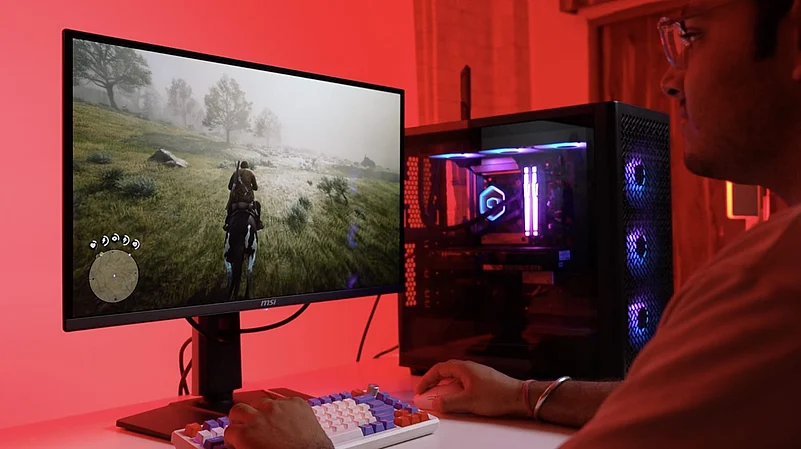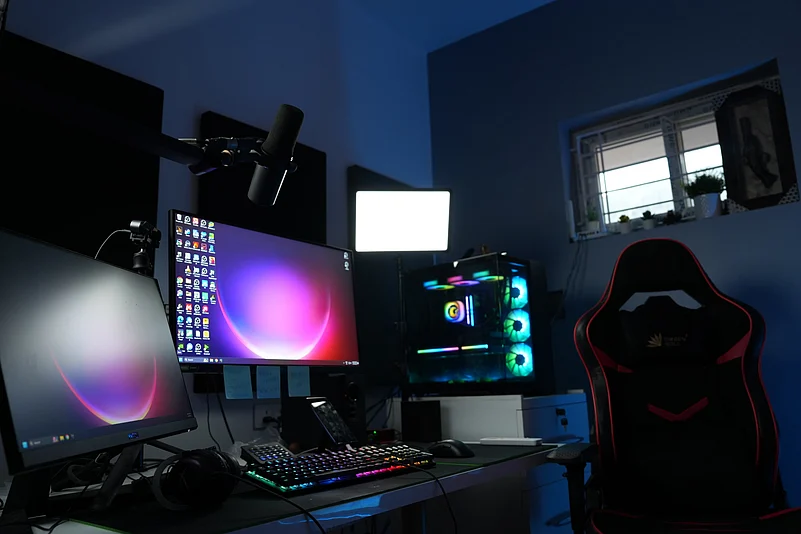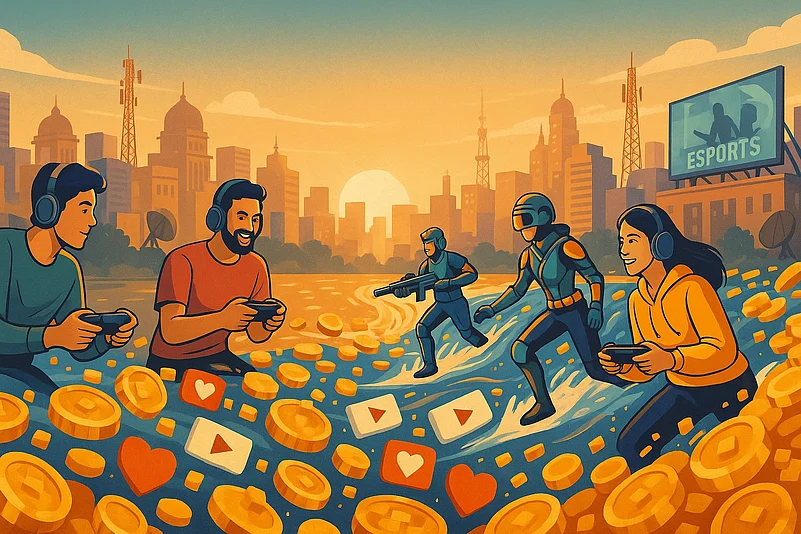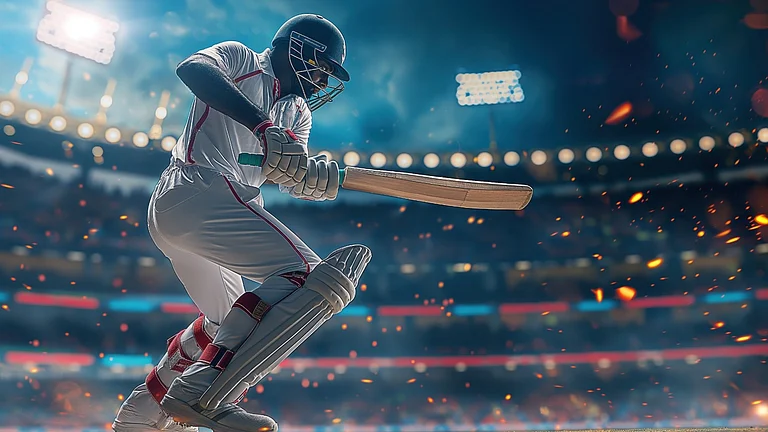
Gaming goes mainstream: India’s gaming industry is booming, set to triple by 2027 with over 600 million users and a rising cohort of full-time creators.
Regional creators rise: Streamers in Tier II and III cities are gaining traction by catering to local languages and culturally resonant content.
Multiple income streams: From AdSense and brand deals to affiliate links and virtual gifting, gaming creators are monetising far beyond views.
Behind the glam: Creators battle burnout, unstable income, and social pressures especially women navigating male-dominated tech spaces.
Shifa Ansari grew up in a conservative home where the focus was always on studies, not screens. “I come from a very modest background,” she says. “I struggled academically, but I’ve always had this instinct to go against the grain. I never wanted to do what everyone else was doing.”
A qualified eye specialist, Shifa is now better known online as Nexgen Harley, one of the few women creators navigating India’s male-dominated tech and gaming space. She began in 2018, filming gadget unboxings on her phone. Today, her YouTube channel features PUBG gameplay, brutally honest tech commentary, and brand collaborations that out-earn her clinic work.
“It started as a side hustle,” she says. “But when I began earning more from content than consulting, I knew I had to pivot.”
India’s gaming economy is exploding. Once dismissed as a “timepass,” gaming is now one of the country’s fastest-growing entertainment sectors. Reports predict the industry will triple by 2027 from ₹23,000 crore to ₹70,000 crore with more than 600 million users and 300,000 active gaming creators. The India Gaming Report 2024 estimates there will be 235 million paying gamers in the country by next year.
Much of this growth has been fuelled by the pandemic and affordable smartphones, pushing platforms like YouTube Gaming, Rooter, and Loco into regional and hyperlocal markets. As a result, a new class of creators now pull live audiences that rival prime-time TV in stickiness. Agencies bundle sponsorships; brands chase hyper-local loyalties; e-sports leaks into living rooms; short-video edits multiply the reach of a single good play.
“After hitting 100K subscribers, the pandemic hit and suddenly everything changed. Gaming exploded, and so did my channel,” says Sankula Venkata Atchuth.
As an introvert who never had friends outside Andhra Pradesh, Atchuth found a new world opening up through streaming. “I met people from Nepal, Gujarat, it was all new to me.”
Rushabh Shah, an influencer marketing lead who’s helped scale gaming creators in Tier-II and Tier-III cities, says the audience has become more “community-led” and “language-loyal.”
“A Hindi creator might struggle in Tamil markets,” he notes. “But a Bhojpuri streamer with 10,000 loyal viewers can still pull in decent revenue. It's all about consistency and cultural resonance now.”
Atchuth agrees. “I wasn’t fluent in English. That’s why I chose to stream in Telugu to connect with my people. And that’s what worked.” He says the support from Andhra and Telangana is stronger than any national audience. “They kept me going,” he adds.
For creators like Ayush Goel aka Lazy Assassin, the decision to go full-time was less about virality and more about following his passion. “I have been gaming since childhood and was already making tech videos, so I thought, why not try a gaming channel too?” he says. “Even after taking a short job post-engineering, I realized I couldn’t handle both, so I chose content full-time.”

He chose content. Today, Ayush earns through YouTube AdSense and brand sponsorships, and adds that the COVID period made monetization and audience growth challenging, though things gradually picked up. “Ad revenue in India is pretty low for gaming, so creators here have to rely on brands to sustain themselves,” he explains.
For Atchuth, it was different. “All my friends were preparing for campus placements. I was the only one skipping interviews because my YouTube income had already doubled and tripled.”

His mother never stopped him. Her only relief was: ‘At least he’s home, not out roaming.’
Anubhav Roy also faced a fork-in-the-road moment. A student turned gamer, he gained traction when he started analysing mobile gaming setups and optimisation hacks.
“Everyone was reviewing PCs or consoles. I focused on how to boost FPS on a budget phone or what headphones actually work under ₹1,000,” he says. “It clicked.”
Now with nearly 70,000 subscribers, Anubhav is working toward building a personal brand that expands beyond gaming into voiceovers, production, and even directing his own short-format videos.
Show Me the Money
Gaming creators today don’t rely on one income stream. Monetisation spans YouTube AdSense, brand campaigns, platform payouts, affiliate links, and community subscriptions.
Apurv Modi, MD at Abhay Health, tracks creator monetisation patterns closely. “A creator can earn ₹500 to ₹3,000 per stream from virtual gifts on platforms like Rooter,” he explains. “And Rooter gives 90% of that revenue to creators much higher than YouTube.”
Atchuth’s early goals were modest. “My short-term goal? Just to pay my Wi-Fi bill myself,” he says.
For Ayush and Anubhav, brand deals remain the largest source of income, often negotiated per reel or campaign. Ayush, for example, has collaborated with a variety of brands from gaming PCs to software companies but he prefers projects where he retains creative freedom. “Some brands let us shoot content in our own style, while others are more instructive. Both are fine, but creative freedom is always better,” he says.
But it’s not always stable. “Some months I’ll land big projects; other times I might not,” says Anubhav. “That’s where savings and planning matter.”
Sakchi Jain, a financial educator who works with multiple gaming influencers, says creators often underestimate back-end complexity.
“They don’t segregate income from revenue. Many forget to track GST or issue proper invoices,” she says. “Once the tax notices hit, it’s a wake-up call.”
Several of her clients have since transitioned to sole proprietorships or LLPs, hired accountants, and started investing in mutual funds and insurance to balance unpredictable earnings.
The Real Grind
However, the real grind, creators say, is invisible.
The decision to go full-time with gaming or tech content isn’t just about subscriber counts or brand deals. For many creators, it also means pushing back against expectations at home.
“My family doesn’t support me,” says Shifa. “They don’t believe I should be working or earning. I’ve never been able to talk to them about what I do, they can’t respect my achievements.”
She adds, “I have to hide it. According to them, a girl should be married by now and raising kids, not building a tech channel. Financial independence isn’t even in the picture. For them, only education matters.”
Female creators also deal with a unique set of challenges, from online harassment to being second-guessed for their knowledge.
“There are hardly any female creators in the PC tech space,” Shifa says with a laugh. “So the response has been really encouraging, and I’m genuinely grateful for it.”
For Anubhav, burnout has come in waves. “Sometimes I just want to not talk to a camera,” he says. “But if I take a break, views drop, brands pause, and recovery takes weeks.”
Jain points out that creators need to build support systems early. “Burnout at 23 is real. Planning for emotional and financial wellbeing has to happen in parallel.”
What’s Next?
Can gaming be a long-term career? Sahil Chopra, Chair of the Indian Influencer Governing Council (IIGC), says yes, but only if the space becomes more ethical and sustainable.
“We’re seeing a rise in undisclosed promotions, especially in gaming where underage audiences are involved,” he warns. “Transparency is non-negotiable.”
The IIGC is developing certification programmes for creators, with workshops on ethical gaming, child safety standards, and financial literacy.
“In other jobs, there’s a clear ladder. In content creation, you have to improve constantly or vanish. But once you learn skills like storytelling, connection, consistency then it’s a full-time career,” says Atchuth.
Creators are also thinking beyond streaming into merchandise, talent agencies, production houses, and offline events.
“I love medicine, but I love this too,” Shifa says. “I’m building something of my own now.”
Rushubh adds that this generation is building intellectual property, not just content. “They’re treating their channels like startups tracking ROI, building teams, analysing engagement dashboards.”
As for Anubhav, he doesn’t plan on leaving this space just yet.
Where does he see himself in five years? “Probably running a studio, hiring editors, maybe launching a product line,” he says. “I don’t want to make content. I want to own the pipeline.”































